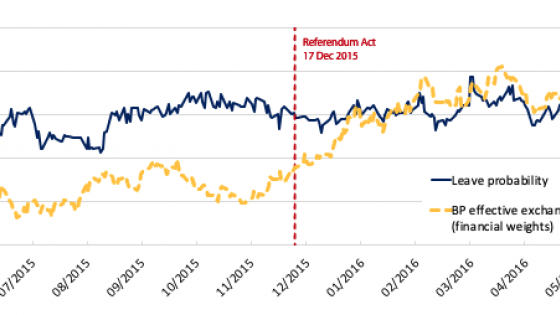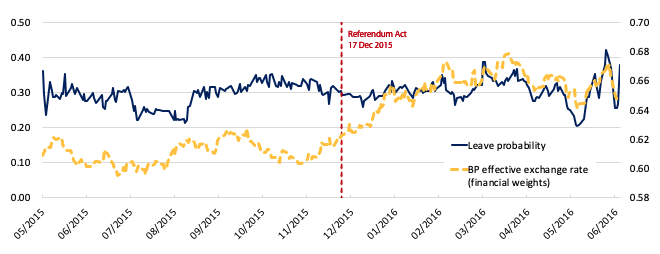Bye-bye European Union! After struggling with the consequences of the Brexit referendum for almost four years, Britain left the EU on 31 January. The debate in the run-up to the referendum had focused mainly on migration, international trade, as well as on Britain’s net contributions to the EU budget. With few exceptions, most economists agreed that Brexit would have negative consequences on the British growth rate (e.g. Sampson et al. 2016: 81), they expressed concerns that the City of London would lose its role as the main market for Euro denominated assets,1 and agreed that Brexiters’ estimates of the UK contributions were grossly exaggerated (European Parliament 2016). Indeed, following the unexpected victory of the ‘Leave’ campaign, the pound depreciated overnight by about 7% against the euro and other main currencies, suggesting that the market expected Brexit to harm the British economy. And yet, on 13 December 2019, currency markets hailed the overwhelming victory of Brexiter Boris Johnson in a general election with a 2% jump of the pound (Figure 1).
Figure 1 The pound appreciates following Johnson’s electoral victory
The success of Boris Johnson was based on the promise of “getting Brexit done” and putting an end to the saga of EU negotiations, votes of no confidence, conspiracies within the Conservative party, talks about a second referendum, and so on. Commentators argued that the pound’s appreciation was due to the end of uncertainty concerning Brexit.2 Yet, the opposite market response to the Brexit referendum and to Johnson’s electoral victory remains puzzling. In a new paper (Manasse et al. 2020), we show that this puzzle can be explained by disentangling the effects that politics has on exchange rate expectations (first moment) and a political risk premium (second moment).
Political risk is notoriously difficult to quantify. The recent literature has proposed indexes of economic and political uncertainty that aggregate multiple sources of primary information to generate widely applicable and relatively long time series (Baker et al. 2016). We take a different approach, exploiting the fact that the Brexit referendum makes for an interesting natural experiment, as the political risk can be measured directly. This is because the vote has been preceded by an exceptionally liquid betting market, where “more than £40 million were gambled in the biggest political betting event in British history”.3 From real-time data on bookmakers’ odds (Betfair and PredicIt), we extract daily series of the (risk-neutral) probabilities of Brexit. These allow us to do two things: pin down market expectations on the pound exchange rates, conditional on the Leave/Remain outcome; and construct a time-varying political risk factor, by computing the daily variance of the probability distribution of the election outcome. Intuitively, political uncertainty/risk increases when the probability of a victory for Leave approaches 50%. In the paper, we address three questions and one methodological issue.
Brexit and the expected depreciation of the pound
Was the probability of leaving the EU associated with movements in the pound, and, if so, why? To answer this, we construct a simple model based on free capital mobility (uncovered interest parity, or UIP) where risk-neutral investors’ hold expectations about post-referendum exchange rates, which depend on the probability of a win for Leave. According to our benchmark estimates, we conclude that an unexpected victory for Leave would imply a 15% depreciation of the pound against all major currencies (an expectations effect), regardless of the bilateral exchange rates considered, the sample periods, and the estimation techniques.
Political risk and the pound
Do currency markets price political risk? If so, how large is the political risk premium? To answer this, we extend the model by considering the portfolio choice problem of a risk-averse currency investor. The data reveal that the political risk premium is positively and highly significantly associated with all of the pound exchange rates considered, except for the exchange rate with the Japanese yen. Thus, as the probability of a Leave win gets closer to 50%, investing in the pound becomes riskier and investors re-allocate their portfolios away from the currency. As a result, we estimate that the elimination of uncertainty the day after the referendum vote would imply an appreciation of the pound by about 8% (an uncertainty effect). The observed depreciation of the pound in the aftermath of the vote of 7% can be decomposed into the two opposite effects: the expectations effect and the political risk effect.
Time-varying (political) risk and uncovered interest parity
Relating time-varying political risk and exchange rates is especially important in the context of the ‘UIP puzzle’. This refers to the fact that while the domestic interest rate should rise to compensate for an expected depreciation of the domestic currency, quite the opposite occurs in the data: the spread between the domestic and the foreign-currency denominated assets is typically weakly or negatively correlated with the depreciation rate of the domestic currency (e.f. Froot and Frankel 1989). In his seminal paper, Eugene Fama argued that the puzzle could be explained either by a failure of rational expectations or by the omission of a time-varying risk premium (Fama 1984). Thus, we ask: Does our direct measure of the (political) risk premium help reconcile the exchange rate behaviour with UIP? The answer is “yes, but only to a certain extent”. For most exchange rates considered, we find that the spread between the domestic and the foreign currency-denominated assets is positively correlated to the depreciation rate of the domestic currency, particularly when we estimate a multi-currency version of our portfolio model and consider a system of exchange rate equations. However, we observe that the coefficients on the interest spread are higher than that predicted by UIP, and that the estimates remain unprecise.
Brexit and methodological issues
One of the striking facts concerning the behaviour of the pound in the period before the vote is that the exchange rate exhibits large jumps following political news concerning Brexit, causing a serious instability in the exchange rate equation parameters. An interesting example occurred in mid-December 2015, when the British parliament promulgated the ‘Referendum Act’. This established the constitutionality of the referendum on the permanence of Great Britain in the EU and dissipated the uncertainty over whether a vote would be called. A few days before the official promulgation of parliament’s decision, the pound started to depreciate against a basket of currencies (see the yellow line in Figure 2, where a rise indicates a depreciation); moreover, following the promulgation of the Act, the exchange rate correlation with the probability of a Leave win increased sharply, with the pound showing a tendency to depreciate when the bookmakers’ probability of a vote to leave the EU increased.
Figure 2 The pound and the probability of a Leave victory
Notes: The figure shows our Leave probability measure (left-hand scale), constructed as the average of the Betfair and PredictIt odds-derived probabilities of Leave, along with the effective exchange rate of the British pound vis-à-vis the basket of 10 currencies considered in the paper (right-hand scale). The effective exchange rate is constructed as the weighted average of bilateral exchange rates using international financial positions as weights. The data are daily and span the period from 27 May, 2015 to 23 June, 2016. The dashed red vertical line identifies the date (17 December, 2015) on which the Referendum Act received Royal Assent.
An interesting feature of our framework is that the parameters of the exchange rate equation depend on the ‘deeper’ parameters which reflect agents' information and preferences, and which are subject to change when crucial Brexit-related news arrives. Our story, for which we find support in the data, is that as soon as investors were ‘sure’ that a referendum would indeed take place, they put more weight on the vagaries of the Leave probability implicit in bookmakers’ odds, and started to worry much more about political risks. This behaviour was reflected systematically in the instability of exchange rate parameters.
Conclusions
The jury is still out as to the growth effects of Brexit on the UK, as this will be largely be determined by the details of the agreements concerning trade, immigration, capital flows, banking regulation, and so on. However, the Brexit referendum has already provided some interesting lessons on the way currency markets are affected by political events and by political risk. First, markets anticipated that Brexit would weaken the British economy. This explains why news of a more likely Leave victory weakened the pound, and why the pound depreciated substantially on impact at the news of the Leave victory. Second, uncertainty over the outcome of the Brexit referendum further contributed to weakening the pound, while the end of uncertainty brought about first by the referendum vote, and later by Boris Johnson’s victory, likely contributed to strengthening the currency. More generally, we believe that a detailed case-by-case analysis of political events is very useful for understanding the relationship between asset prices and political risk, and to tackle the issue of parameter instability in analysing asset price movements. Our approach can be applied to a variety of political events and allows the exploitation of information that aggregate indexes of political uncertainty cannot deliver.
References
Baker, S R, N Bloom, and S J Davis (2016), “Measuring economic policy uncertainty," The Quarterly Journal of Economics 131(4): 1593-1636.
European Parliament (2016) “The UK 'rebate' on the EU budget. An explanation of the abatement and other correction mechanisms”, briefing, February.
Fama, E F (1984), “Forward and spot exchange rates", Journal of Monetary Economics 14: 319-338.
Froot, K A and J A Frankel (1989), “Forward discount bias: Is it an exchange risk premium?", The Quarterly Journal of Economics 104(1): 139-161.
Manasse, P, G Moramarco and G Trigilia (2020), “Exchange Rates and Political Uncertainty: The Brexit Case”, DSE Working Paper, University of Bologna.
Sampson, T, S Dhingra, G Ottaviano, and J Van Reenen (2016), “Economists for Brexit: A critique”, Centre for Economic Performance.
Endnotes
1 See https://www.reuters.com/article/uk-britain-eu-banks-passport/europeans-warn-of-brexit-threat-to-uks-crucial-bank-passports-idUKKCN0Z11YZ
2 See, for example, https://edition.cnn.com/2019/12/12/investing/pound-uk-election/index.html
3 See https://www.nytimes.com/2016/06/23/business/international/brexit-britain-gambling-bookies.html







